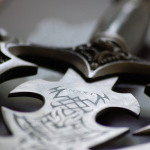Created by: paul01234
Number of Blossarys: 51
A sword substitute often used in training all over the world so that none of the participants draw blood and/or gravely injure each other. Some arts have foregone the use of the sword and use the ...
A true double handed sword (the name literally means "two-hander") that requires both hands to use the sword. It slowly became more of a polearm than a sword due to its length.
A Japanese shortsword used alongside the katana. Wearing the wakizashi along the katana indicated that the wearer was an official samurai. Wearing them together, the pair of swords would be called ...
A Japanese broadsword. It is straight, unlike its more famous brother the katana. The Kusanagi-no-Tsurugi, one of the Three Imperial Regalia, is said to be a tsurugi and not a katana.
A straight two edged sword used in the martial art of Taijiquan. The modern version of Wushu uses a lighter version to allow for quicker movement, but the weight is what allows the body to be ...
A curved sword designed for cutting. The saber has a guard extending all the way down the hilt to protect the hand from injury. Not closely related to the use of the saber in fencing.
A thin sword designed for thrusting attacks, with a very ornate, elegant, and complex hilt to prevent damage to the wielder's hand. It can cut but the thinness of the blade made it more practical to ...


 English (EN)
English (EN)